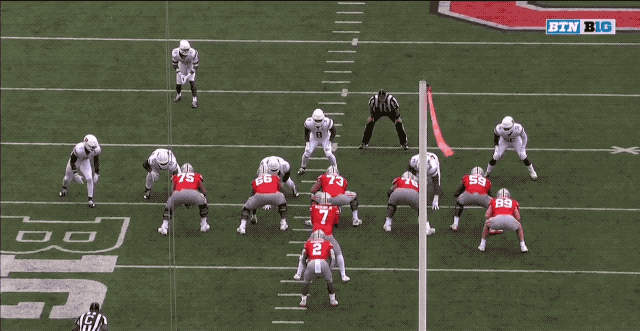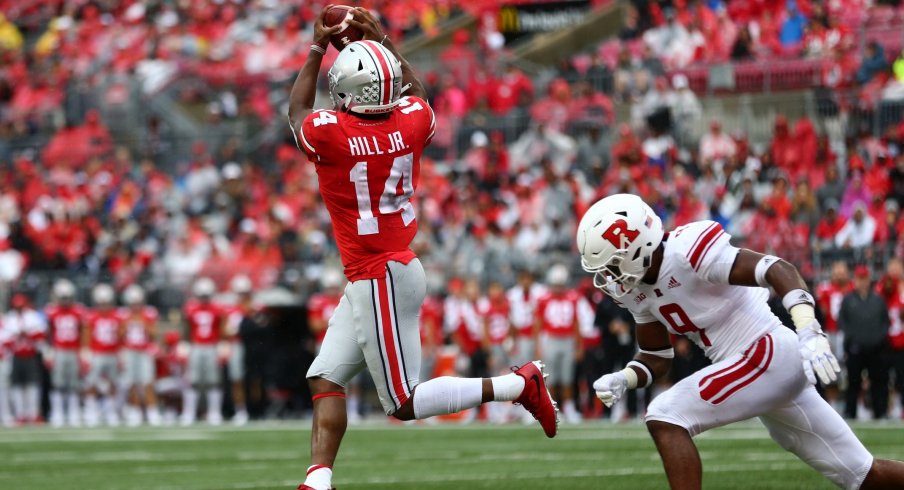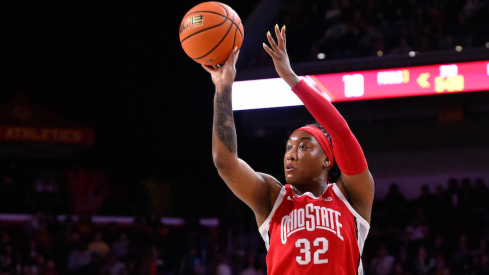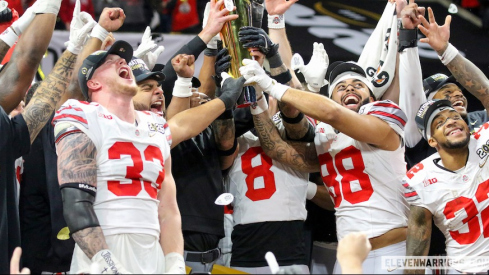"You don’t know who is going to get the action. But when you’re team players and you don’t care who gets the attention, that’s when you can be a special group." - Ohio State interim head coach, Ryan Day.
Since becoming a head coach at Bowling Green in 2001, Urban Meyer has famously stressed one point above all others when it comes to his offensive philosophy. 18 years later, the top bullet point on the first page of his playbook still reads, "Get the ball in the hands of our playmakers. Utilize personnel – don’t force a square peg in a round hole."
That certainly seemed to be true in the early stops in his career, magnifying overlooked talents like Josh Harris and Cole Magner at Bowling Green before elevating Alex Smith to the number one pick in the draft at Utah. At Florida and now, Ohio State, there has been a bevy of dynamic talents to whom the ball could travel, be they running backs, slot-receivers, or a hard-nosed running quarterback.
But this season in Columbus, that philosophy appears to be taking a slightly different form as the entire offense has seemingly been re-shaped to fit the talents of one player: quarterback Dwayne Haskins.
Fans both casual and maniacal have born witness to an explosion of offensive production in the first two weeks of the 2018 season, seeing the Buckeyes cruise to a national-best 129 points and racking up more yards than anyone besides Oklahoma State in the process. Unlike the Cowboys, who put up their gaudy numbers against weathervane schools like Southwest Missouri State and South Alabama, Ohio State beat up on a pair of Power-5 programs.
Already the offense, led by play-callers Ryan Day and Kevin Wilson, has amassed 1,300 yards - 600 on the ground and 700 through the air - signaling a remarkable balance for which many fans have been longing. Not only does it feel like watching a different team than seasons past, in many ways it actually looks like it too.
While the Buckeyes have remained a shotgun-run team, mixing a variety of gap and zone schemes as they always have, this year the group seems to be relying far more heavily on outside zone runs than they ever had in years past. This focus can likely be attributed directly to Wilson, but it fits the qualification of getting playmakers like J.K. Dobbins and Mike Weber the ball while penalizing the defense for overloading the A-gaps as defenses should they try to slow down the inside run game.

But the run play most fans were interested in seeing has yet to show up. Even on 3rd & short, we have yet to see Haskins keep the ball on an option play and run for a first down, a staple of Meyer's offense ever since Tim Tebow was under center in Gainesville.
Instead, Haskins has relied on his arm, throwing off his option read to hit bubble screens and arrow routes to the flat that get the ball to K.J. Hill or Parris Campbell in the open field.
While this may feel different, not seeing the quarterback barrel through arm tackles on his way to a four-yard gain, the reality is this is still very much the same system we saw last fall with J.T. Barrett under center. The formation and concept shown above were a staple of the system last fall, attacking the pattern-matching Michigan State defense by splitting all four receivers to the wide side of the field and creating confusion, especially when the offense was running at an uptempo pace between snaps.
Similarly, as we saw countless times in the past, the Snag concept provided an easy window to spring an open receiver in goal-line and short-yardage situations.
Unlike the last few years, though, the Buckeyes have been successful connecting on deep balls, finding receivers downfield and leaving defenders in their tracks. As we saw in April's spring game, simply repackaging the same play in new ways leaves the defense on their heels, just as they did with Saints in the third quarter by replacing the bubble screen to the boundary with a fade-smash concept.
While having a quarterback with the arm talent and confidence to drop in passes both deep and short makes a massive difference, the real secret to the unit's success has been the effectiveness of both game plans thus far. Not only did a wealth of new concepts keep both the Beavers and Scarlet Knights on their heels throughout both afternoons, they were designed to hit the defense at their weakest points.
"We’ve seen a lot of quarters film, so we were trying to plan up some post routes today," Haskins said of the Rutgers defense following the game. "Just being able to, with the weather and seeing Johnnie get open like that, it’s a lot of fun for me. Basically, he’s wide open for me from that perspective."
Of course, Rutgers' base defense remains the same, pattern-matching Quarters scheme that carried Ohio State to a national title in 2014 with Chris Ash in charge. In such a scheme, the cornerbacks effectively play man-to-man coverage with the outside receiver while the safeties take the inside receiver in what is effectively a matchup-zone defense.
But knowing the rules of such coverage as well as the Ohio State staff does at this point, they knew that those safeties could be easily manipulated by the inside (#2) receiver's movements, creating separation for a quick throw or isolating receivers against a lone defender down the field.
That all being said, it's easy to forget that despite this complete supposed overhaul of both the personnel and the playbook this season, Ohio State still finished seventh in total offense last fall, averaging 506 yards-per-game. And although Oregon State and Rutgers both belong to conferences with their own cable networks, the two programs combined for only five wins a year ago.
Though maybe not cupcakes, these blueberry muffin-style opponents offer plenty of cheap calories for an Ohio State offense that looks unstoppable right now, just as it did a year ago when it averaged 608 ypg against teams with a losing record, only to see that number dip dramatically to 429 ypg when playing opponents above .500.
The true test of the unit will come this Saturday in AT&T Stadium against a worthy opponent in TCU. The Horned Frogs have surrendered only 213 ypg, and have undoubtedly kept an eye on the Buckeyes over the past nine months.
TCU head coach Gary Patterson is famous for preparing ahead of time, admitting at July's Big 12 media days that he'd already watched every Ohio State game from last fall at least three times in an effort to find 'an answer' to what they'll offer. For that reason alone, one can't help but wonder if Day and Wilson have emptied the playbook in an effort to distract and overwhelm their most difficult early-season opponent, only to revert to what has worked in the past once they enter a high-pressure environment in Arlington.
But thus far in 2018, the focus seems to be shifting away from the Ohio State head coach's core mantra. Instead of focusing on the best players, the Buckeyes seem content with the idea that everyone in the unit is capable of breaking the game wide open.
"Everybody, the thing I told the receivers that doesn’t matter what game it is or what day of practice it is, anybody can get the ball," Haskins added after the Rutgers game. "And whether it’s Terry one week or anybody else another week, I just want them to run the routes like they’re getting the ball every single time and calling the play."



